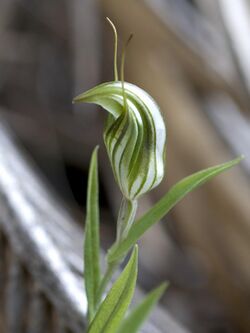Biology:Pterostylis scabra
| Green-veined shell orchid | |
|---|---|

| |
| Scientific classification | |
| Kingdom: | Plantae |
| Clade: | Tracheophytes |
| Clade: | Angiosperms |
| Clade: | Monocots |
| Order: | Asparagales |
| Family: | Orchidaceae |
| Subfamily: | Orchidoideae |
| Tribe: | Cranichideae |
| Genus: | Pterostylis |
| Species: | P. scabra
|
| Binomial name | |
| Pterostylis scabra Lindl.[1]
| |
| Synonyms[2] | |
|
Diplodium scabrum (Lindl.) D.L.Jones & M.A.Clem. | |
Pterostylis scabra, commonly known as the green-veined shell orchid, is a species of orchid endemic to the south-west of Western Australia. As with similar orchids, the flowering plants differ from those which are not flowering. The non-flowering plants have a rosette of leaves but the flowering plants lack a rosette and have a single flower with leaves on the flowering spike. This greenhood has a white flower with green and pale brownish-fawn stripes and a long, curved protruding labellum. It is found in inland areas between Kalbarri and Esperance.
Description
Pterostylis scabra is a terrestrial, perennial, deciduous, herb with an underground tuber and when not flowering, a rosette of leaves lying flat on the ground, each leaf 10–40 mm (0.4–2 in) long and 2–3 mm (0.08–0.1 in) wide. Flowering plants have a single flower 30–40 mm (1–2 in) long and 10–12 mm (0.4–0.5 in) wide borne on a flowering stem 60–180 mm (2–7 in) high. The flowers are white with green and pale brownish-fawn stripes. The dorsal sepal and petals are fused, forming a hood or "galea" over the column, the dorsal sepal curving forward with a short pointed tip. The lateral sepals are erect with a small gap between them and the galea and have thread-like ends 30–35 mm (1.2–1.4 in) long. The labellum is long, narrow and down-curved, protruding prominently above the sinus between the lateral sepals. Flowering occurs from May to August.[3][4][5]
Taxonomy and naming
Pterostylis scabra was first formally described in 1840 by John Lindley and the description was published in the A Sketch of the Vegetation of the Swan River Colony.[1][6] The specific epithet (scabra) is a Latin word meaning "rough", "scurfy" or "scabby",[7] referring to the rough surface of the labellum.[3]
Distribution and habitat
The green-veined shell orchid is found in inland areas between Kalbarri and Esperance in the Avon Wheatbelt, Esperance Plains, Geraldton Sandplains, Jarrah Forest and Mallee biogeographic regions.[3][4][8]
Conservation
Pterostylis scabra is classified as "not threatened" by the Western Australian Government Department of Parks and Wildlife.[8] It usually grows in moist, shaded areas, often near temporary streams but also grows in woodland and on granite outcrops.[3][4]
References
- ↑ 1.0 1.1 "Pterostylis scabra". APNI. https://id.biodiversity.org.au/instance/apni/488876. Retrieved 5 August 2017.
- ↑ "Pterostylis scabra". World Checklist of Selected Plant Families (WCSP). Royal Botanic Gardens, Kew. http://wcsp.science.kew.org/namedetail.do?name_id=170651.
- ↑ 3.0 3.1 3.2 3.3 Brown, Andrew; Dundas, Pat; Dixon, Kingsley; Hopper, Stephen (2008). Orchids of Western Australia. Crawley, Western Australia: University of Western Australia Press. p. 349. ISBN 9780980296457.
- ↑ 4.0 4.1 4.2 Hoffman, Noel; Brown, Andrew (2011). Orchids of South-West Australia (3rd ed.). Gooseberry Hill: Noel Hoffman. p. 401. ISBN 9780646562322.
- ↑ Archer, William (2011-07-26). "Pterostylis scabra". Esperance Wildflowers. http://esperancewildflowers.blogspot.com.au/2011/07/pterostylis-scabra-shell-orchid.html. Retrieved 5 August 2017.
- ↑ Lindley, John (1840). A Sketch of the Vegetation of the Swan River Colony. London: James Ridgway. p. liii. https://archive.org/details/sketchvegetatio00goog. Retrieved 20 June 2017.
- ↑ Brown, Roland Wilbur (1956). The Composition of Scientific Words. Washington, D.C.: Smithsonian Institution Press. p. 670.
- ↑ 8.0 8.1 "Pterostylis scabra". FloraBase. Western Australian Government Department of Parks and Wildlife. https://florabase.dpaw.wa.gov.au/browse/profile/1697.
Wikidata ☰ Q15492993 entry
 |

